The US Naval Air Systems Command (NAVAIR) is evaluating a proposal from Sikorsky to build four production-representative CH-53K Super Stallion heavy-lift helicopters, says the US Marine Corps' programme manager.
"We're looking at the proposal now," says Col Robert Pridgen.
NAVAIR received the proposal at the beginning of March, he says. A contract award is expected some time after this has been evaluated, although Pridgen says: "I don't want to nail down a date."
The four pre-production aircraft will be "fleet-representative" and be used for operational evaluations, as well to finish developmental testing.
 |
|---|
© Sikorsky |
The CH-53K is now scheduled to become operational in 2019 - one year later than previously slated - and the Marines hope to buy about 200 of the three-engined type.
When the programme first started, the service only wanted to buy 156 aircraft, Pridgen says. Initial operational capability was then set for late 2015, but the USMC upped the order and stretched the programme out by three years in August 2007. Production numbers were to have reached as many as 227, before they were trimmed back to 200.
The USMC will continue to operate the legacy three-engined CH-53E until the new "Kilo" model replaces it, but plans to retire its remaining twin-engined CH-53Ds at the end of 2012.
Development of the CH-53K is moving ahead smoothly, Pridgen says. One senior Marine official singled out the programme as a "good news story".
Despite the CH-53 designation, the K-model helicopter is a clean-sheet design incorporating all-new technology, Pridgen says. It has a fly-by-wire control system and new engines, as well as a split-torque transmission described by Pridgen as a "work of art", composite rotor-blades and a new cabin, all designed using CATIA-5 computer-aided design software.
If all continues to go smoothly, "we'll go flying [in] 2014", Pridgen says.
However, that first flight will be preceded by the start of integration testing on a ground test vehicle that is currently under construction at Sikorsky's facilities in West Palm Beach, Florida.
"That's going to occur in 2013," Pridgen says.
The ground test vehicle will have most of the subsystems of a flyable aircraft, including the cockpit, hydraulics, rotor-head and composite blades.
"It will truly be integration for us to understand what the aircraft looks like dynamically," Pridgen says.
A number of subsystems are already being tested in preparation for installation in the ground test airframe. The CH-53K's 7,500shp (5,600kW) General Electric GE38-1B turboshaft engine design has already accumulated over 1,100h in test and Pridgen says: "We've been testing components for some time now."
Sikorsky has also built a static test airframe, which is being used to determine how the helicopter handles the structural loads that will be imposed on it in flight. That testing is underway at the company's facility in Connecticut.
Only after the new helicopter satisfactorily completes those tests will the aircraft be cleared for flight, Pridgen says.
Two flight test vehicles that will be used for developmental purposes are currently in production in West Palm Beach.
Once basic flight tests prove that the helicopter is airworthy, the Marines intend to start operational testing on the four pre-production aircraft, in conjunction with finishing developmental tests.
"With that data I will do something called operational test 1B," Pridgen says. "And that's where we bring Marines in."
The USMC's VMX-22 operational test squadron will verify the service's requirement to lift 12,300kg (27,000lb) at a 6,000ft (1,830m) pressure altitude on a 35˚C (95˚F) day, roughly three times the lift capacity of the CH-53E. The helicopter is also required to carry that load over a distance of 110nm (204km).
The unit will also make sure the aircraft is suitable for fleet use and integrate it into the USMC's order of battle. Only after these tests have taken place will the Marines approve low-rate initial production, which Pridgen expects to occur in 2015.
Source: Flight International



















